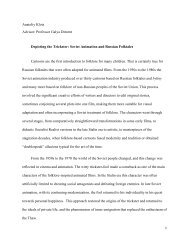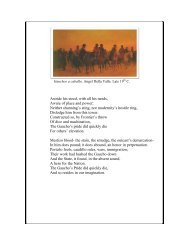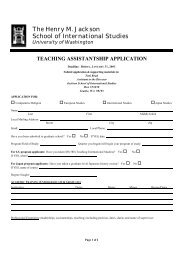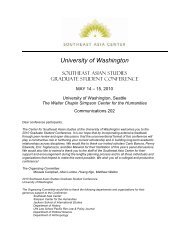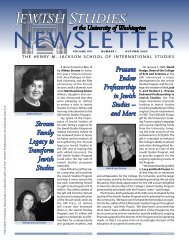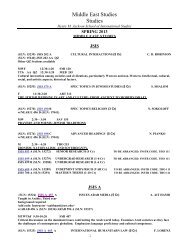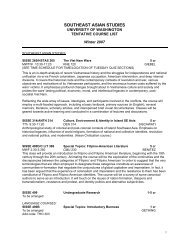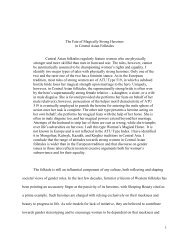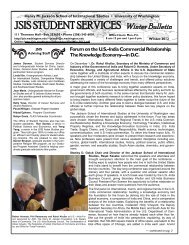Cobblestone Publishing Kamishibai for Kids - Jackson School of ...
Cobblestone Publishing Kamishibai for Kids - Jackson School of ...
Cobblestone Publishing Kamishibai for Kids - Jackson School of ...
Create successful ePaper yourself
Turn your PDF publications into a flip-book with our unique Google optimized e-Paper software.
National Consortium <strong>for</strong> Teaching about Asia (NCTA) Classroom Materials Descriptions<br />
Religions and Philosophies in China: Confucianism, Daoism, and Buddhism $59.95 – Middle<br />
<strong>School</strong> to Secondary<br />
The study <strong>of</strong> China is not complete without exploration <strong>of</strong> the historical roots and practice <strong>of</strong> its three main<br />
religions and philosophies: Confucianism, Daoism, and Buddhism. This award-winning curriculum unit<br />
uses a variety <strong>of</strong> activities and resources to learn about these world religions and philosophies in a<br />
Chinese context. Throughout each lesson, students are encouraged to compare and contrast each<br />
religion and philosophy as well as to think critically about the universality and modern-day applicability <strong>of</strong><br />
their tenets. Includes 37 slides. 2002.<br />
Traditional Chinese Celebrations: Continuity and Change in Taiwan $29.95 – Elementary to Middle<br />
<strong>School</strong><br />
Four lessons, one on each <strong>of</strong> four major Chinese festivals, introduce Chinese culture at an elementary<br />
school level. Each lesson includes four slides. Festivals covered are: The Lantern Festival (which<br />
concludes the Lunar New Year Festival,) Tomb Sweeping (or Qing Ming), Dragon Boat Festival, and the<br />
Moon (or Mid-Autumn) Festival. Student activities and discussion questions lead students to identify the<br />
similarities and differences between Chinese and U.S. cultural traditions. (Note: Pictures were taken in<br />
Taiwan, but can be used to illustrate the culture <strong>of</strong> mainland China as well.) 1985.<br />
Japan:<br />
An Introduction to Japanese Buddhist Art $39.95 - Middle <strong>School</strong> to Secondary<br />
This unit introduces students to expressions <strong>of</strong> Buddhism in art in the Japanese context. Lessons on art<br />
history, Buddhism, religious institutions, and curatorial practices encourage students to see art in more<br />
ways than one. Students also learn about Buddhism's basic tenets and practices, and develop an<br />
appreciation <strong>for</strong> Buddhist cultural achievements by studying images <strong>of</strong> Buddhism. Features art <strong>of</strong> the<br />
Ruth and Sherman Lee Institute <strong>of</strong> Japanese Art at the Clark Center, Han<strong>for</strong>d, CA. Includes CD-ROM<br />
and daruma doll. 2004.<br />
Castle Towns: An Introduction to Tokugawa Japan $44.95 - Middle <strong>School</strong> to Secondary<br />
This unit is a slide-based introduction to life in Japan during the late feudal period (16 th -19 th centuries).<br />
The slides focus on architecture and defense features <strong>of</strong> the castle, the rise <strong>of</strong> castle towns as nascent<br />
urban centers, and on those who lived in the castle towns. A castle town maze, an activity designed <strong>for</strong> 7 th<br />
to 9 th grade students, adds a first-hand sense <strong>of</strong> how towns were established to protect the castle from<br />
opposing <strong>for</strong>ces. Supplementary materials <strong>for</strong> both students and teachers can be used to extend the unit.<br />
1981.<br />
Civil Rights and Japanese-American Internment $179.95 – Secondary to Community College<br />
This six-lesson curriculum module <strong>of</strong>fers students the opportunity to consider civil right issues in the<br />
context <strong>of</strong> the Japanese-American experience during the immigration years and during World War II.<br />
Videos, books, and photographs. 2001.<br />
Cooperation in Japan, Elementary Literature Series: Part I $42.95 – Elementary<br />
Utilizes primary source material and 32 slides to introduce themes <strong>of</strong> cooperation, working as a team, and<br />
sacrifice <strong>for</strong> the common good in Japanese culture. The story “Fly, Big Carp Streamer” uses a story about<br />
the custom <strong>of</strong> flying fish-shaped banners on Children’s Day (May 5) as an entry point <strong>for</strong> explorations <strong>of</strong><br />
cultural themes. Children can help make a carp-shaped banner <strong>for</strong> the class. Another lesson focuses on<br />
the Japanese custom <strong>of</strong> <strong>School</strong> Sports Day. 1990.<br />
Diamonds in the Rough: Baseball and Japanese-American Internment $64.95 – Middle <strong>School</strong> to<br />
Secondary<br />
The purpose <strong>of</strong> this curricular guide is not only to introduce Japanese-American internment through the<br />
prism <strong>of</strong> baseball but also to encourage students to consider civil liberties during times <strong>of</strong> crisis. This<br />
guide (with accompanying book and documentary DVD) can be used as a supplement to SPICE’s<br />
comprehensive curriculum unit, Civil Rights and Japanese-American Internment. 2004.<br />
5



